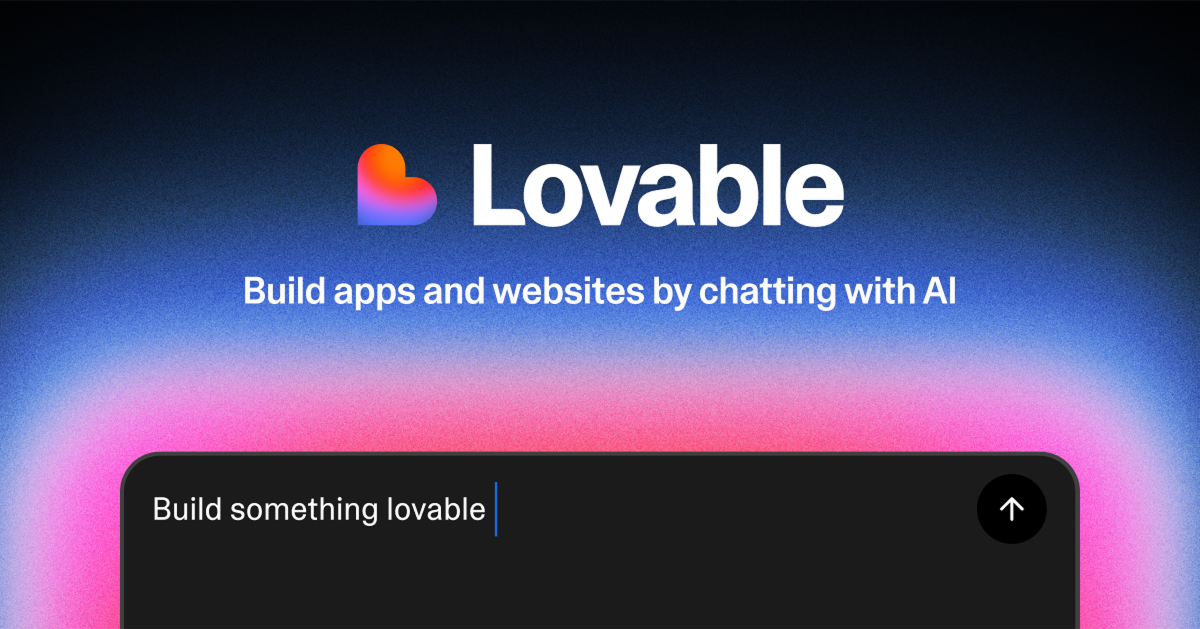Demand generation tools are crucial for businesses aiming to attract, engage, and convert potential customers effectively.
With a staggering 85% increase in pipeline from anonymous web visitors using tools like Lift AI, and email marketing boasting a return of $42 for every $1 spent, the significance of these tools cannot be overstated.
In this short guide, we’ll explore the top 10 demand generation tools available in 2024.
Key Takeaways
- Demand generation tools are essential for improving conversion rates and customer engagement.
- Integrating automation and AI features can significantly boost marketing efficiency.
- Choosing the right tool can lead to substantial ROI and improved lead management.
Top 10 Picks for Demand Generation Tools
- MNTN Performance TV – Best for high-impact streaming ads
- HubSpot – Best for comprehensive inbound marketing
- Salesforce Pardot – Best for B2B marketing automation
- Mailchimp – Best for user-friendly email marketing
- Leadfeeder – Best for identifying website visitors
- OptinMonster – Best for conversion optimization
- Google Analytics – Best for web traffic analysis
- Hootsuite – Best for social media management
- Ahrefs – Best for SEO and content marketing
- Lift AI – Best for AI-driven lead scoring
How We Evaluated Demand Generation Tools
The evaluation process for demand generation tools focused on these key criteria:
- Functionality: The range of features offered to enhance lead generation and customer engagement.
- User Experience: The ease of use and accessibility of the platform.
- Integration Capabilities: How well the tool integrates with existing marketing technology stacks.
- Pricing Structure: Affordability and value provided at various pricing tiers.
- Customer Support: Availability of resources and assistance for users.
The methodology involved testing these tools, consulting with industry experts, and conducting thorough online research, ensuring we present the most relevant and effective options available.
Demand Generation Tools Comparison Table
| Software | Best For | Key Features | Pricing | Free Plan | Platforms Available |
|---|---|---|---|---|---|
| MNTN | High-impact streaming ads | CTV marketing, dynamic targeting, reporting suite | Custom pricing | No | Web |
| HubSpot | Comprehensive inbound marketing | CRM, email marketing, automation | Free, $45-$3,200+ | Yes | Web, iOS, Android |
| Salesforce Pardot | B2B marketing automation | Email marketing, lead scoring | Starts at $1,250/month | No | Web |
| Mailchimp | User-friendly email marketing | Campaign management, A/B testing | Free, from $13/month | Yes | Web, iOS, Android |
| Leadfeeder | Identifying website visitors | Visitor identification, lead scoring | Starts at $63/month | No | Web |
| OptinMonster | Conversion optimization | Targeted forms, A/B testing | Starts from $9/month | No | Web |
| Google Analytics | Web traffic analysis | User tracking, goal setting | Free, Google Analytics 360 available | Yes | Web |
| Hootsuite | Social media management | Scheduling, analytics | Starts at $19/month | No | Web, iOS, Android |
| Ahrefs | SEO and content marketing | Keyword research, site audits | Starts at $99/month | No | Web |
| Lift AI | AI-driven lead scoring | Buyer intent scoring, real-time insights | Starts at $1,500/month | No | Web |
1. MNTN Performance TV
Best for high-impact streaming ads
MNTN is a performance marketing platform that specializes in connected TV (CTV) advertising.
Its unique Creative-as-a-Subscription™ service allows businesses to run high-impact ads with dynamic targeting tools.
With an intuitive reporting suite, MNTN provides insights that help optimize ad performance and drive conversions.
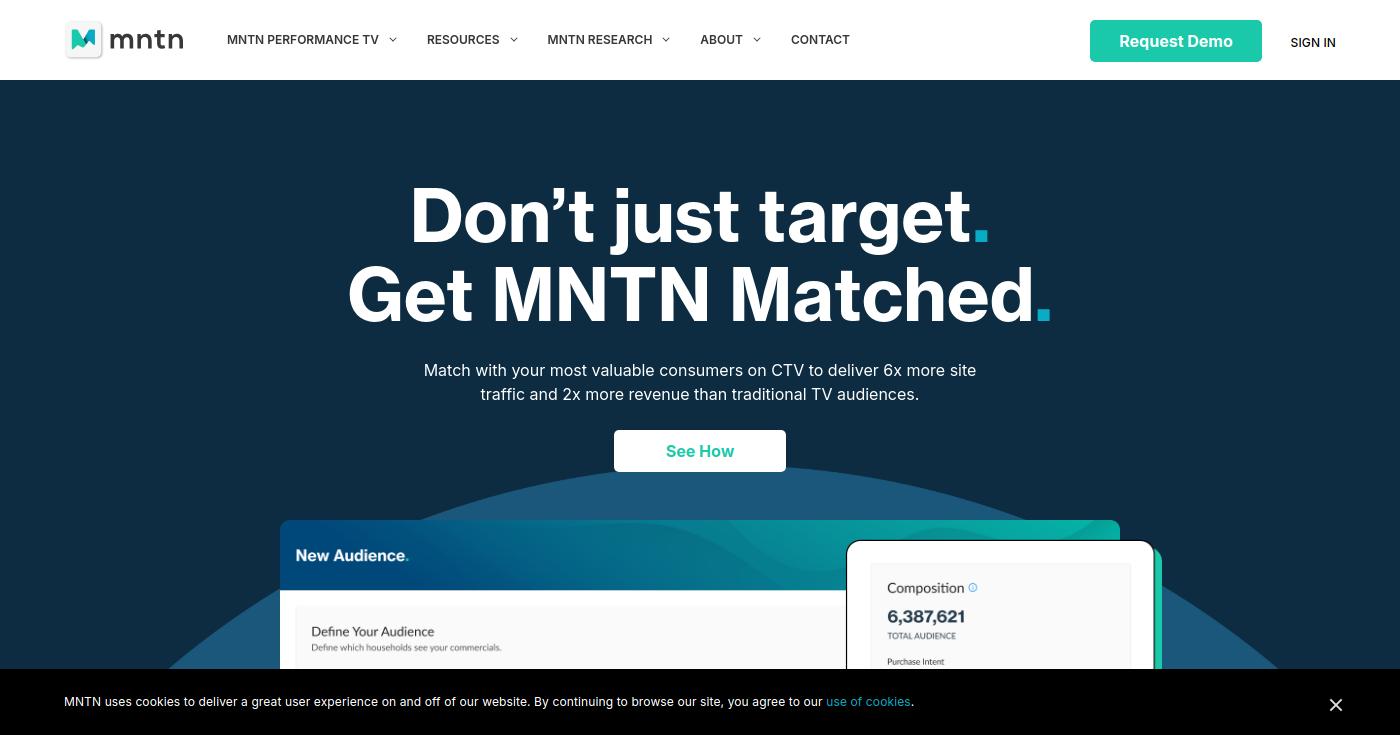
Pros
- Focuses on measurable performance.
- Easy-to-use interface for ad creation.
- Dynamic targeting increases ad relevance.
Cons
- Custom pricing may not suit all budgets.
- Limited features for non-video advertisers.
Key Features
- CTV Marketing: Engage audiences on popular streaming platforms.
- Dynamic Targeting: Tailor ads to specific audience segments.
- Intuitive Reporting: Access to detailed performance metrics.
Pricing
MNTN offers custom pricing based on the specific needs of your business. It’s recommended to request a demo for tailored information.
2. HubSpot
Best for comprehensive inbound marketing
HubSpot serves as an all-in-one marketing platform that integrates CRM, email marketing, and social media management.
Its robust marketing automation features help businesses streamline their operations and enhance customer engagement.

Pros
- Comprehensive features in one platform.
- Strong community support and resources.
- Free tier available for startups.
Cons
- Advanced features can be expensive.
- Steeper learning curve for new users.
Key Features
- CRM Integration: Seamlessly manage customer relationships.
- Email Marketing: Create targeted email campaigns effortlessly.
- Marketing Automation: Automate repetitive tasks to save time.
Pricing
HubSpot offers a free plan with paid options ranging from $45 to $3,200+ per month based on features.
3. Salesforce Pardot
Best for B2B marketing automation
Salesforce Pardot specializes in B2B marketing automation, offering features like lead scoring, email marketing, and CRM integration.
It allows businesses to effectively track and nurture leads throughout the sales funnel.
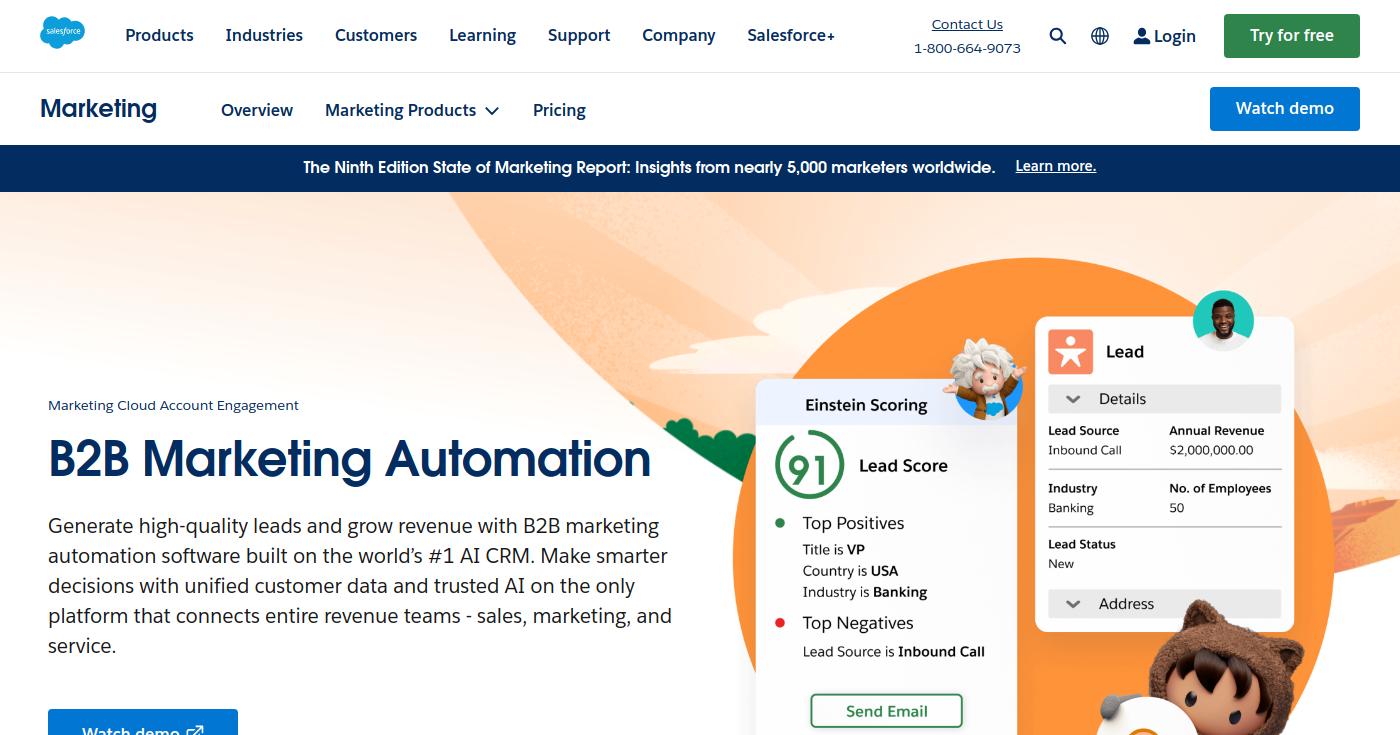
Pros
- Deep integration with Salesforce CRM.
- Advanced analytics for better decision-making.
- Customizable workflows to fit business needs.
Cons
- Higher starting price compared to competitors.
- Complexity may overwhelm small businesses.
Key Features
- Lead Scoring: Prioritize leads based on engagement.
- Email Marketing: Create personalized campaigns for leads.
- Advanced Analytics: Gain insights into marketing performance.
Pricing
Salesforce Pardot starts at $1,250 per month for basic features.
4. Mailchimp
Best for user-friendly email marketing
Mailchimp is renowned for its intuitive email campaign management and automation capabilities.
It offers audience segmentation and A/B testing to optimize marketing efforts.
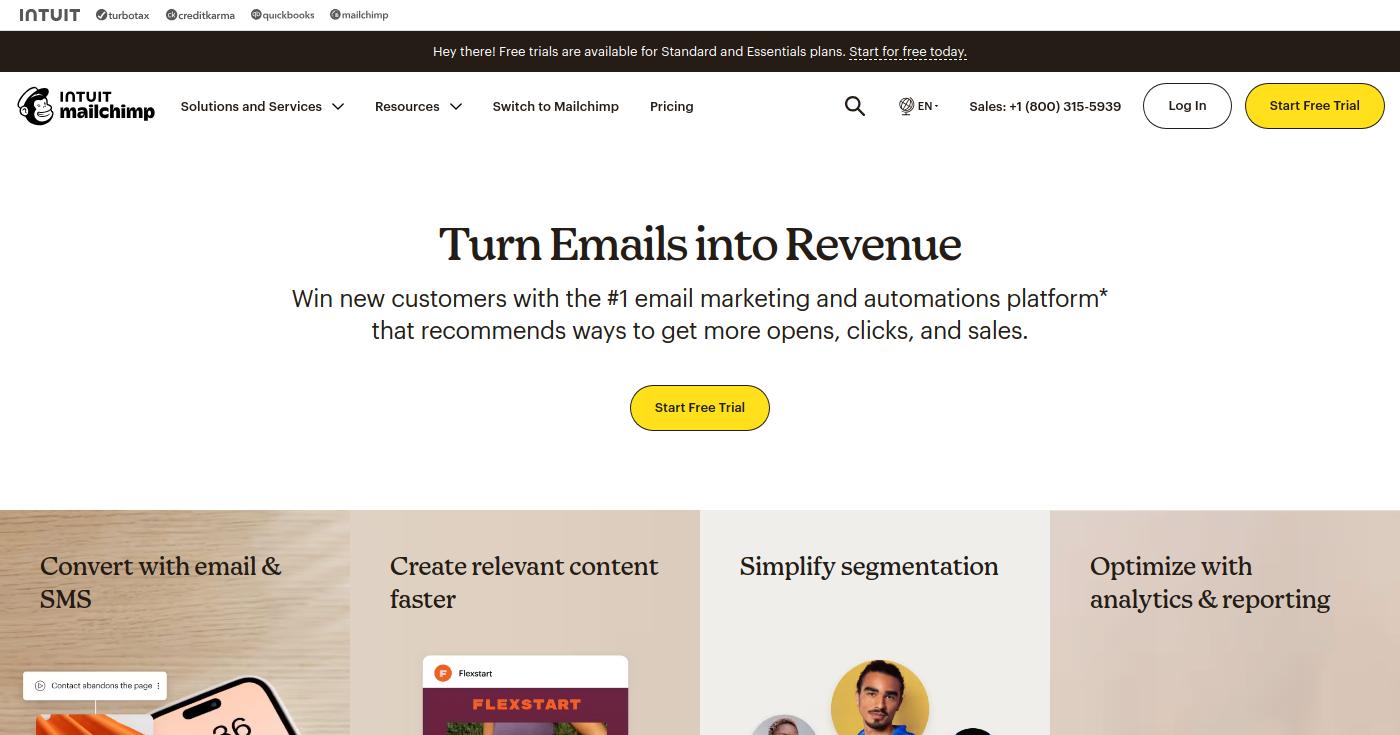
Pros
- User-friendly interface for beginners.
- Extensive library of templates.
- Free plan available for small businesses.
Cons
- Limited features in the free plan.
- Pricing can escalate with advanced features.
Key Features
- Audience Segmentation: Target specific groups effectively.
- A/B Testing: Optimize email campaigns based on performance.
- E-commerce Integration: Connect seamlessly with online stores.
Pricing
Mailchimp offers a free plan, with paid plans starting at $13 per month based on features.
5. Leadfeeder
Best for identifying website visitors
Leadfeeder helps businesses identify companies visiting their website, providing insights into potential leads.
Its real-time tracking and lead scoring features enable targeted follow-ups.
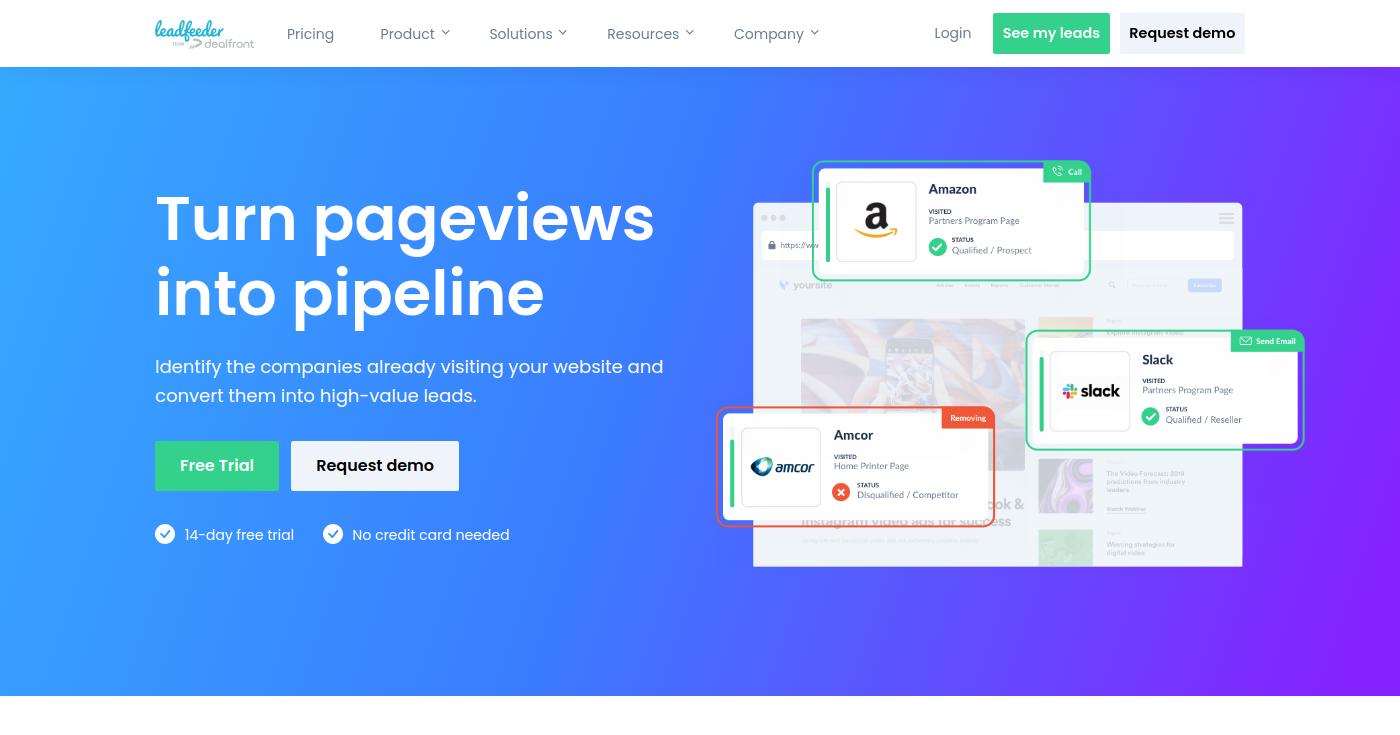
Pros
- Reveals anonymous website visitors.
- User-friendly interface for lead tracking.
- Integration with Google Analytics for enhanced insights.
Cons
- Limited features for non-B2B companies.
- May require manual data entry for some features.
Key Features
- Visitor Identification: See which companies are engaging with your site.
- Lead Scoring: Prioritize leads based on activity.
- Real-Time Tracking: Monitor visitor behavior as it happens.
Pricing
Leadfeeder starts at $63 per month for the Lite plan.
6. OptinMonster
Best for conversion optimization
OptinMonster is a powerful conversion optimization tool that enables businesses to create targeted opt-in forms and pop-ups.
It focuses on growing email lists and improving conversion rates.

Pros
- Highly customizable opt-in forms.
- Advanced targeting options to capture leads.
- Integration with numerous email marketing services.
Cons
- Limited features in lower-tier plans.
- Pricing may be high for small businesses.
Key Features
- Targeted Opt-In Forms: Capture leads based on user behavior.
- A/B Testing: Test different campaigns for effectiveness.
- Analytics Dashboard: Monitor performance metrics easily.
Pricing
OptinMonster plans start from $9 per month.
7. Google Analytics
Best for web traffic analysis
Google Analytics is essential for businesses looking to understand their website performance.
It provides insights into user behavior, goal tracking, and audience segmentation.
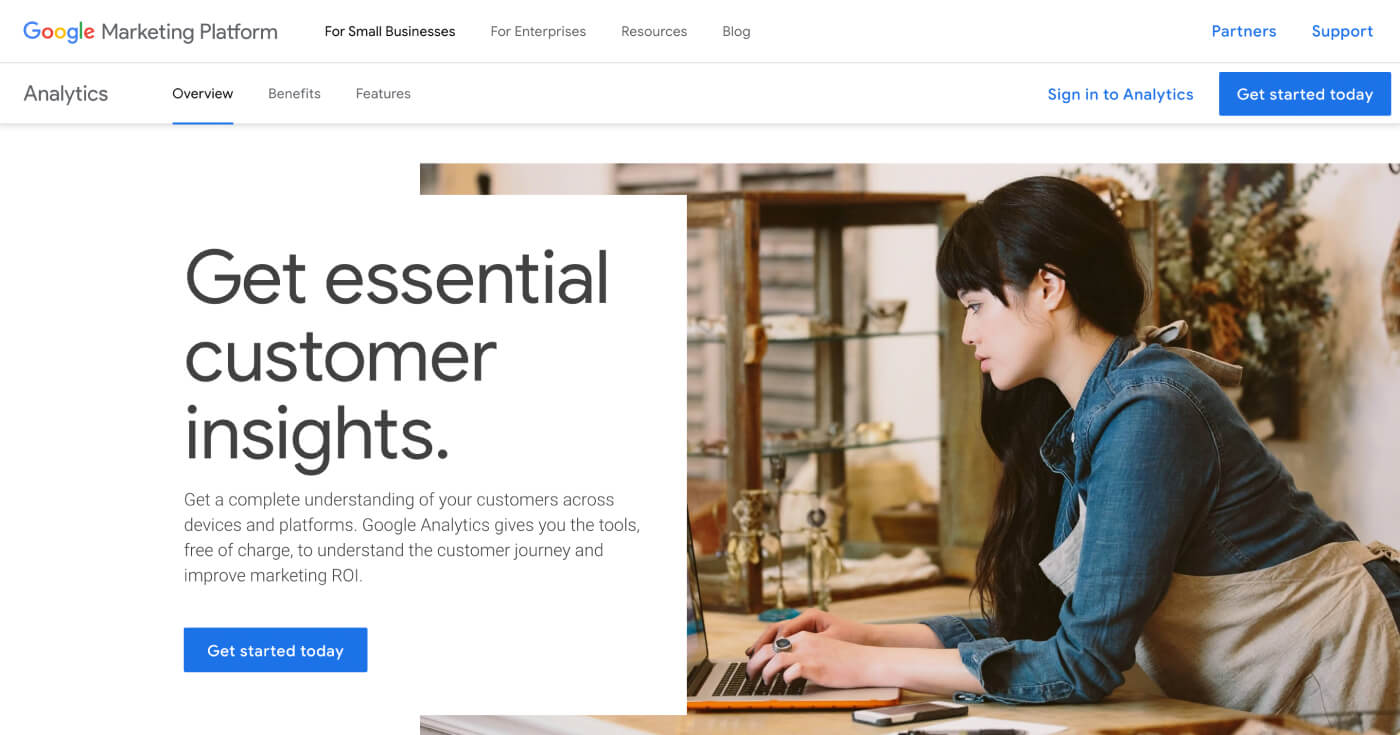
Pros
- Free for standard use; robust features.
- Comprehensive reporting capabilities.
- Customizable dashboards and metrics.
Cons
- Can be overwhelming for new users.
- Requires setup to unlock full potential.
Key Features
- User Behavior Tracking: Understand how visitors interact with your site.
- Goal Tracking: Measure conversions and key performance indicators.
- Audience Segmentation: Analyze different user groups.
Pricing
Google Analytics is free for standard use, with a premium version available for enterprises.
8. Hootsuite
Best for social media management
Hootsuite centralizes social media activities, enabling businesses to manage multiple platforms, schedule posts, and analyze performance.
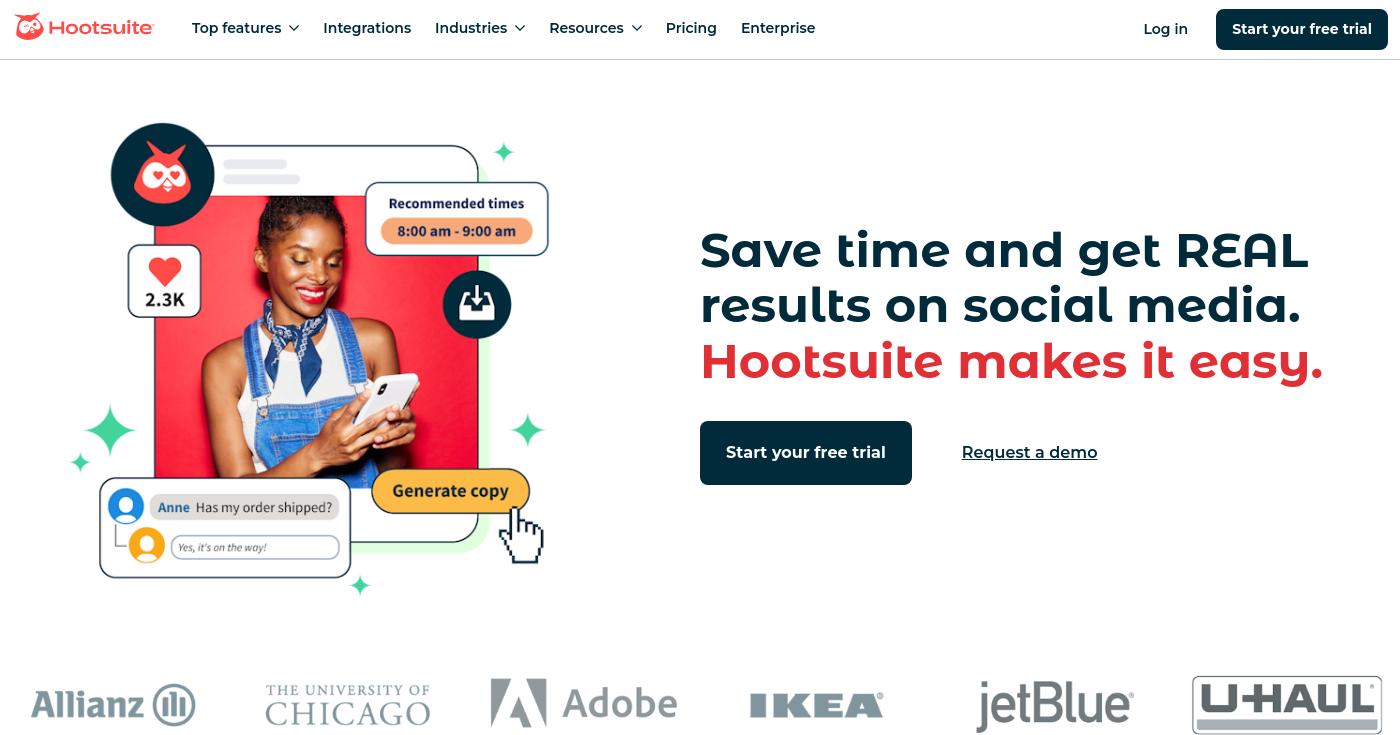
Pros
- Supports multiple social media platforms.
- User-friendly interface for scheduling.
- Comprehensive analytics features.
Cons
- Pricing may be high for small businesses.
- Some features can be complex to navigate.
Key Features
- Social Media Scheduling: Plan and automate posts across platforms.
- Analytics Dashboard: Monitor social media performance in real-time.
- Social Listening: Track brand mentions and engagement.
Pricing
Hootsuite plans start at $19 per month.
9. Ahrefs
Best for SEO and content marketing
Ahrefs provides a comprehensive suite of SEO tools, including keyword research, site audits, and backlink tracking, making it a favorite for content marketers.
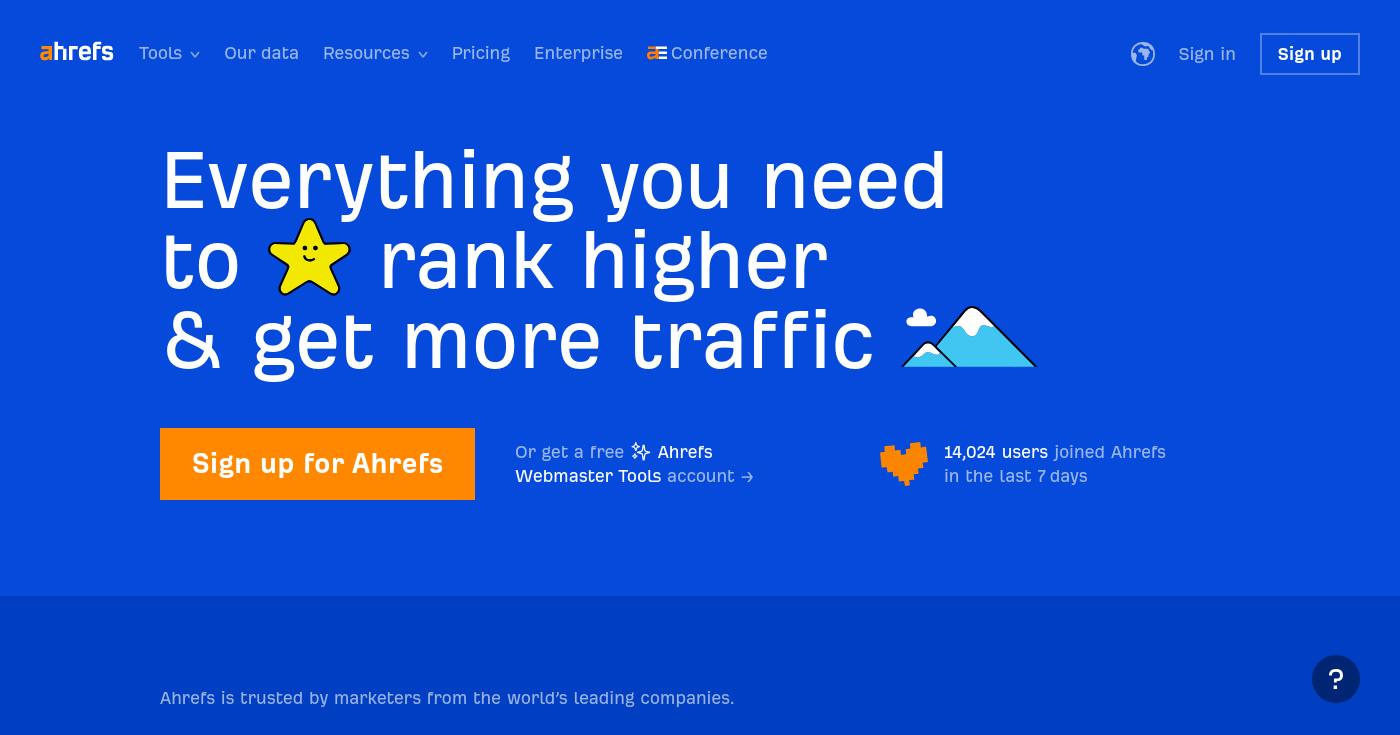
Pros
- Extensive database for keyword research.
- Powerful site auditing tools.
- User-friendly interface with detailed insights.
Cons
- Higher pricing compared to some competitors.
- Can be overwhelming for beginners.
Key Features
- Keyword Research: Discover high-traffic keywords for your niche.
- Backlink Tracking: Monitor your site’s link profile.
- Site Audits: Identify SEO issues and opportunities.
Pricing
Ahrefs starts at $99 per month.
10. Lift AI
Best for AI-driven lead scoring
Lift AI leverages artificial intelligence to provide real-time insights on website visitors. Its buyer intent scoring helps improve lead engagement and conversion rates.
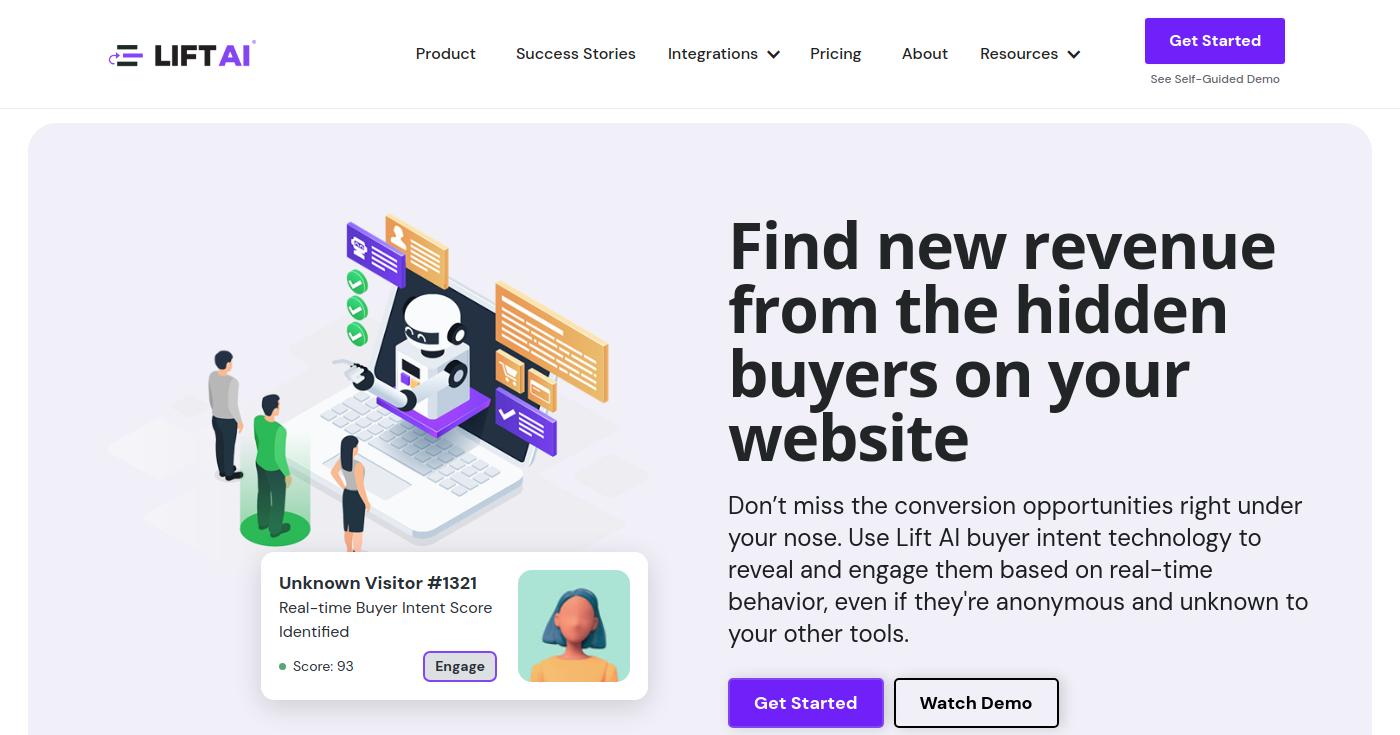
Pros
- AI-driven insights enhance lead scoring.
- Seamless integration with existing marketing tools.
- Real-time visitor tracking capabilities.
Cons
- Higher pricing may not fit all budgets.
- Limited support documentation available.
Key Features
- Buyer Intent Scoring: Understand which leads are most likely to convert.
- Real-Time Insights: Track visitor behavior as it happens.
- Integration Capabilities: Connect with various marketing tools and platforms.
Pricing
Lift AI starts at $1,500 per month for the Essentials plan.
How to Choose the Right Demand Generation Tools for Your Needs
Selecting the ideal demand generation tools depends on your specific requirements and use case. Consider these crucial factors:
- Functionality: Assess the features that align with your marketing goals.
- Budget: Evaluate pricing structures and return on investment.
- Scalability: Ensure the tool can grow with your business needs.
Understanding common misconceptions about demand generation tools can also help in making informed decisions.
Many believe that all tools are created equal, but the reality is that each tool caters to different aspects of demand generation, making it essential to choose wisely.
Emerging Trends in Demand Generation Tools
As we move through 2024, several trends are shaping the demand generation landscape.
- The integration of artificial intelligence across platforms is enhancing predictive analytics, allowing businesses to tailor their outreach more effectively.
- Additionally, there is a growing shift towards integrated platforms that combine various functionalities, simplifying the marketing tech stack for businesses.
Making the Right Choice for Your Demand Generation Needs
Choosing the right demand generation tools is vital for optimizing your marketing strategies and driving conversions.
Evaluate your unique business needs and explore the top picks that have been highlighted in this guide.
Frequently Asked Questions about Demand Generation Tools
What are the best demand generation tools for 2024?
The best demand generation tools for 2024 include MNTN, HubSpot, Salesforce Pardot, Mailchimp, Leadfeeder, OptinMonster, Google Analytics, Hootsuite, Ahrefs, and Lift AI.
How do I improve lead generation with automation?
Improving lead generation with automation involves utilizing tools that can help you streamline processes, personalize outreach, and analyze data effectively.
What are the costs associated with demand generation tools?
Costs vary widely depending on the tool and its features, with free plans available for some and others starting at $9/month to over $1,500/month.
Are there free demand generation tools available?
Yes, several demand generation tools, such as Mailchimp and Google Analytics, offer free plans with limited features.
What trends should I consider in demand generation tools?
Key trends include the rise of AI in marketing automation, the focus on integrated platforms, and the continued importance of data-driven decision-making.

